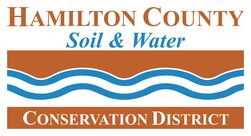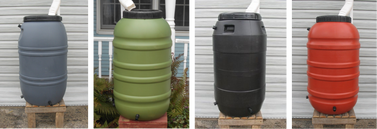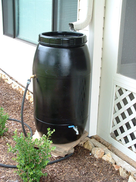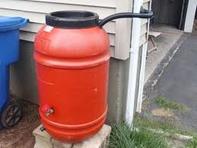Rain Barrels
|
Rain barrels are a great source of free soft water for watering plants, irrigation, and other outdoor household chores. A rain barrel can save you 1,500 gallons of water a year!
How do I install my barrel?
Placement:
There are multiple ways to install rain barrels. Below are two common options. Whichever option you choose, elevating your barrel off the ground on a sturdy base will be necessary to create water pressure and allow you to place a bucket or watering can under the spigot. Stands can be built or purchased and concrete blocks work nicely. Always be sure your barrel is stable and consider stabilizing your barrel by attaching it to your home via straps or another mechanism. Always keep your rain barrel lid on and secure to prevent mosquito larvae from breeding and to prevent drowning hazards. Some communities in our county offer special programs or discounts on rain barrels for their residents. Learn more below.
|
Pre-Order Pick Up: Pick up for pre-ordered barrels will be Wednesday May 22nd between 9am and 6pm in Noblesville (details will be emailed to customers as pick up approaches - check your spam folder). After pre-orders close on May 15th, rain barrel ordering will close until May 28th when remaining supplies will be available for sale and immediate pick up from our office. We encourage you to pre-order to guarantee availability and color selection. Shop Rain Barrels and AccessoriesYou do not need to be a Hamilton County, Indiana resident to place an order in any of the SWCD sales but you do need to pick up in Noblesville, Indiana.
|
Installing your rain barrel
|
Option 1- Elbow connection on downspout:
1. Place your barrel near the downspout you have selected, and plan out how you will direct the downspout. Be sure to consider creating a base for your barrel as mentioned in "installation" above. 2. Disconnect your downspout by sawing the downspout above where the top of the rain barrel will be, leaving room for the elbow to be attached. 3. Attach a downspout elbow to the end of your downspout so that water from your downspout is directed into the rain barrel through the screen vent on top. 4. If you have an aluminum downspout, secure it to the elbow with screws. 5. Place your rain barrel under the downspout elbow. 6. Optional: Create an overflow hole on the top-side of the barrel and attach tubing to direct overflow. Make sure that the overflow is directed into your own yard. Note: Retain the cut off portion of your downspout to re-attach in winter when your barrel is removed (see maintenance instructions). |
.Option 2- Downspout diverter:
Downspout diverters can be purchased at the SWCD. These diverters install directly into your downspout and allow a portion of the rain water traveling down your downspout to be redirected into your barrel. When the barrel is full, the rain water continues down the downspout. This method eliminates the need for overflow hoses and leaves your downspout intact. Diverters are for sale at the SWCD and in our online store (no shipping) There is a diverter installation YouTube video below. Installation is quick and easy. |
Maintenance:
Periodically check the screen and remove large debris by hand. If necessary, remove lid and spray screen and lid with hose to clean.
Algae is not usually a problem as the runoff from your roof should be low in nutrients. If algae growth becomes a problem with your barrel, empty the barrel and wash it with a diluted bleach solution of 3/4 cup of bleach per gallon of water. Rinse the barrel well after bleaching.
Barrels will crack due to freezing and thawing if left outside in the winter. Remove your barrel before if freezes in winter and store it upside down (indoors if possible). If you installed your barrel with Option 1, reattach the piece of downspout you cut during installation. If installed with a diverter, detach the diverter hose and use the winter cover to cover the downspout hole.
Periodically check the screen and remove large debris by hand. If necessary, remove lid and spray screen and lid with hose to clean.
Algae is not usually a problem as the runoff from your roof should be low in nutrients. If algae growth becomes a problem with your barrel, empty the barrel and wash it with a diluted bleach solution of 3/4 cup of bleach per gallon of water. Rinse the barrel well after bleaching.
Barrels will crack due to freezing and thawing if left outside in the winter. Remove your barrel before if freezes in winter and store it upside down (indoors if possible). If you installed your barrel with Option 1, reattach the piece of downspout you cut during installation. If installed with a diverter, detach the diverter hose and use the winter cover to cover the downspout hole.



